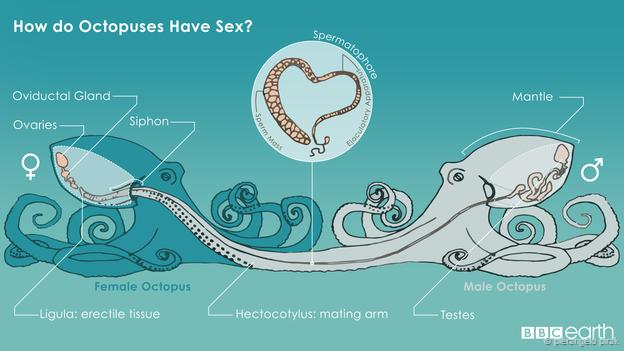And oh, how I wish I could say it was me who came up with that title!
But it wasn’t; it was the BBC, headlining a fascinating article about how octopuses get it on.
It seems it’s rather difficult to be a male octopus with mating on his mind. Like a female spider, his prospective partner may end up dining on him.
In octopuses (& their relatives, squid, cuttlefish, & nautilus), males don’t have a penis. Instead, they produce packets of sperm – spermatophores – which they must then pass the female using a specialised arm called a hectocotylus (which does contain erectile tissue).
Squid practice a form of drive-by mating, slapping a spermatophore onto the outside of the female’s body. It’s pretty indiscriminate. In fact there was a report last year of a woman who ended up with squid spermatophores embedded inside her mouth, through eating parboiled squid – the hectocotylus still had some life in it.
Male octopuses, on the other hand, use that specialised arm to place their sperm packet well inside the female’s mantle cavity, close to her ovaries. As you can imagine, this generally requires a certain amount of close contact, which is when things may get downright risky and in some species an unlucky male may finish his days as his beloved’s meal. In one recorded incident
A female [Wonderpus photogenicus] used constricting as a form of fatal aggression to asphyxiate a male as part of apparent sexual cannibalism.
This image by Pierangelo Pirak is from the BBC article, and shows what’s involved in octopode sex.
In some species the risk is minimised by having very long arms, and even by mating while the female is distracted, and in the blanket octopus the male simply detaches his hectocotylus & leaves it with his mate: an entirely reasonable tactic given the huge difference in size between male and female.
I was intrigued to hear that in some species there are ‘sneaker males’ – smaller individuals who may even hide that specialised mating arm in order to sneak in & mate with someone else’s partner. This does not always end well either:
The smaller males wait until a larger guarding male has left the den, then covertly mate with the female. As a result, they are called “sneaker” males. They have even been known to disguise themselves as females, hiding their hectocotylus to make a less threatening approach to a guarded female.
This sly tactic can occasionally backfire, as it did in an instance caught on film by Huffard. A sneaker male approached a burrow where he seemingly sensed a female was hiding. As he reached an arm in, an octopus emerged. But it was not the female: it was her guarding male. Unsurprisingly, this big male was not impressed by the sneaker male’s attempt to insert a hectocotylus into his mantle.
And a somewhat mind-boggling fact to end on: the spermatophore of a male Pacific octopus is almost a metre long, and may take an hour to transfer to the female. I think it goes without saying that this must be one of the ‘friendlier’ species!

ifthethunderdontgetya™³²®© says:
Putting on a leisure suit and heading off to the disco doesn’t seem so difficult now, does it?
/Leisure Suit Larry
~
Alison Campbell says:
It would certainly beat being squeezed to death by an amorous octopus!